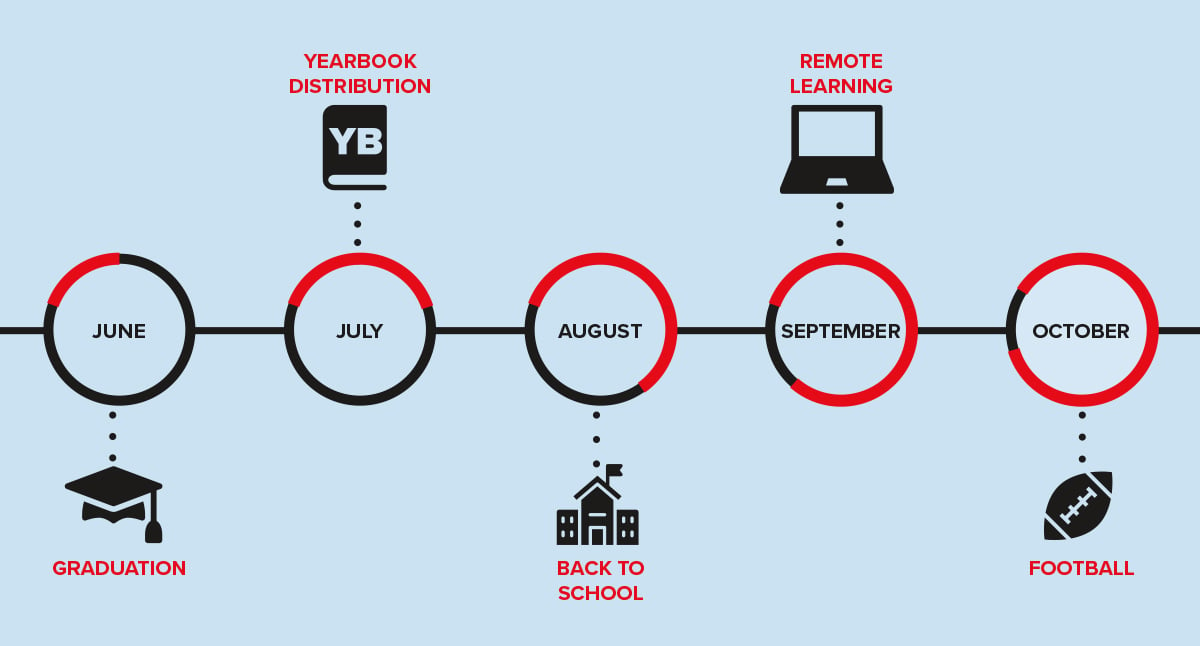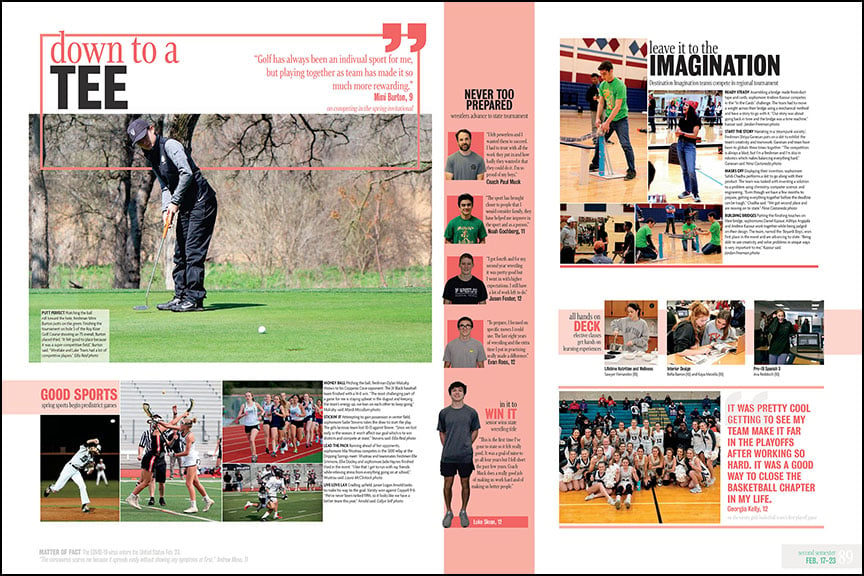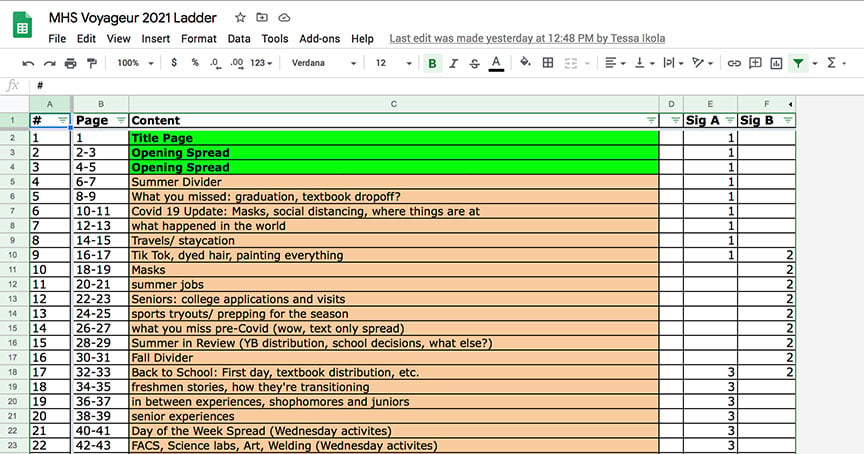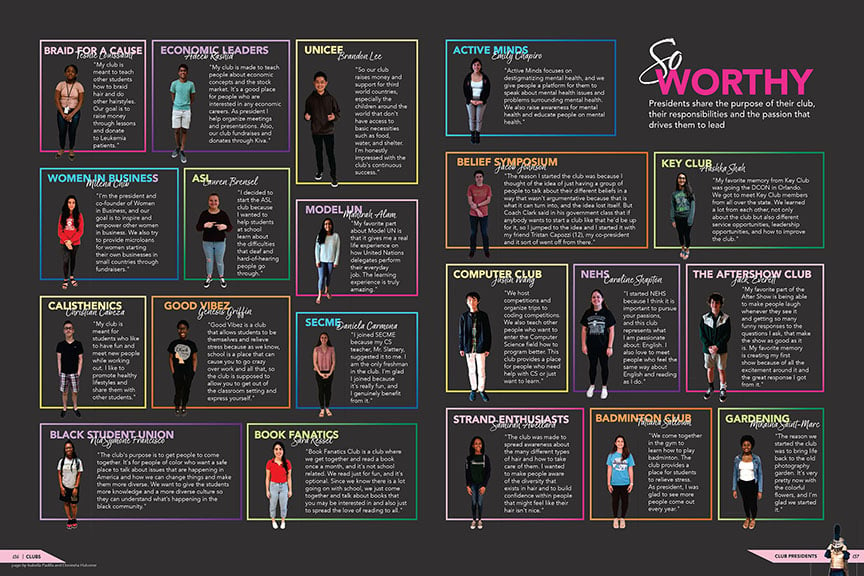
Will football games happen? When will clubs get to meet? When will everyone be back on campus? With all the uncertainty surrounding this school year, there’s one thing that’s abundantly clear: this year's yearbook should be organized chronologically.
Yearbook staffs rely heavily on sports’ schedules, in-person classes and traditional events. But that was all upended last spring when seasons were disrupted, events canceled and school moved online. Suddenly, staffs had blank pages in random spots throughout their books. No one wants to face that dilemma again.
Goodbye traditional, hello chronological
For this year at least, it’s time to say au revoir to traditional sections. For those new to yearbook, a traditionally organized book divides into sections—typically: student life, people, academics, clubs/organizations and sports.
Instead, say hello to a chronological yearbook. This sequential arrangement organizes pages in the order topics and events occur. The chronology can vary by:
• Week
• Month
• Semester/Quarter
• Season
Seasonal books are the most common with sections for summer, fall, winter and spring. (Some schools choose to omit the summer section if they don’t have coverage). Dividing the book into semesters requires less division pages while a monthly approach needs quite a few more (sometimes staffs minimize dividers by including several months on the same one).
Weekly is the newest type of chronological organization with each spread dedicated to a week or two weeks at a time. Weekly organization lends itself to a blended coverage approach to design and content. Also called umbrella coverage, a blended approach allows classes, clubs, events and sports to share space on the same spread. In chronological books, staffs may give some groups their own spreads, while others have modules sprinkled throughout the book as their events happen.
What about the people section? In a chronological book, staffs have options where to place the portraits: in the section it happened, in a separate people section, or in the reference section at the end (before the group photos, ads and index).

This spread from Vandegrift High School features several events that happened the week of Feb. 17-23, including sports events, class activities and a club’s competition.
Why is going chronological important?
The unknown makes the chronological format the best choice for this year. If the worst-case scenario happens and schools shut down again, you don’t want to be left with 20 pages of sports or clubs to fill. But if your content is structured as events occur, you don’t have to worry about that problem. You’ll fill in pages as the year happens.
This type of organization also benefits books because it forces staffs to cover what really happened during the year. No more generic class note-taking photos or clubs sitting at a meeting. It also usually eliminates weaker student life topics that don’t lend themselves to good photo opportunities. Goodbye cliché car spreads or relationships page (which often feature couples broken up by the time the book arrives).
The side benefit is you’ll complete more signatures which makes yearbook production easier and more efficient. Ideally for spring books, about 50 percent of your signatures should be completed by January. Often, a sig can’t be printed because there’s a lone spread not submitted. A chronological organization removes that problem.
How do we do it?
You might be apprehensive about a chronological book if you’ve never done one. Here’s a few tips for newbies:
1. Consider seasonal or semester for the simplest format. Weekly is a very cool proposition, but it requires your staff to be on top of things every week. However, if you love the idea of blending coverage, Hendrickson High School and Vandegrift High School are two strong weekly yearbooks. You can download their books (as well as other chronological books) here. Can’t access Hightail? Check our Google Drive which has the books separated by type of chronological format. Feel free to add a viewable-only version of your ladder to help other staffs.
2. Make a list of things you want to cover. By now, your students have made plans for a masks spread and one on Zoom calls. What else do they want to feature?
3. Use a Google Sheet to plan and adjust topics on the ladder. This will let remote classes plan together and make changes easily. You can always transfer the information later to the hard copy ladder (we recommend laminating it and using dry erase markers; if we’ve learned anything this year, flexibility is key.)
4. Use last year’s ladder as a starting off point. You need a reference to what you covered last year. Ultimately, some topics and events will go by the wayside, but much of it will still be incorporated in one way or another. If you were a traditional book, you’ll have to decide where to place events, classes, clubs and sports. Sports are the easiest since they tend to fall into a certain time of year. For other topics, think about when they are busiest or most involved. For example, if physics classes don’t do the egg drop experiment till December, it’s not helpful to put a science spread in the fall section.

Minnetonka High School’s ladder features a seasonal chronology with academic, student life and sports coverage in their fall section.
5. Consider whether you’ll cover groups in more than one section. This is one of the more challenging decisions with chronological books. Will you continue to give a group their own spread? What if they’re involved all year long? Many staffs take a mixed approach to this. Groups that are very active might continue to receive their own spread. But it might only be featured in one section. Some schools choose to give the group coverage in each section, sometimes in shared space, sometimes as their own spread. For example at Rouse High School, in the past the staff has given a fall and winter spread to theatre, one for the fall play and class productions, and one for the spring musical.
6. Think creatively for how you’ll cover clubs and classes. This is where the fun and innovation comes into play. You have the opportunity to do something really different this year. We all know we’ll have Zoom spreads. But how are teachers engaging students? How are classes conducting experiments or creating art? There is so much potential with how you cover academics in this book.
Clubs will be the more difficult question. You’ll need to find out how groups are meeting and which ones are active. Then comes the creative question: how will you cover? One benefit to seasonal coverage is many staffs forgo separate club coverage. They blend by time: fall clubs, winter clubs, spring clubs. Whenever the group was active, that was when they were covered.
If organizations are able to meet, you can still take a blended approach, but mixing by topic: fundraising, T-shirts, volunteering, holiday parties, activities, etc. Another option is to take a Q&A or cutouts and quotes approach to club coverage, featuring numerous clubs on a spread and getting students’ reflections on their group or a specific club-related question.

Cutouts and quotes might be an ideal approach to club coverage if organizations are unable to meet in person this year. In their 2019 book, Suncoast High School featured 20 different clubs, focusing on each group’s president.
Adaptability key benefit to chronological organization
We know a new format can be scary. But this change will benefit the book and your staff. A chronologically organized yearbook will provide flexibility as the year progresses and changes. You’ll be able to adjust to unexpected surprises and adapt spreads to match what does happen. In a year that won’t be easy, this is one decision that will make life a little easier.

